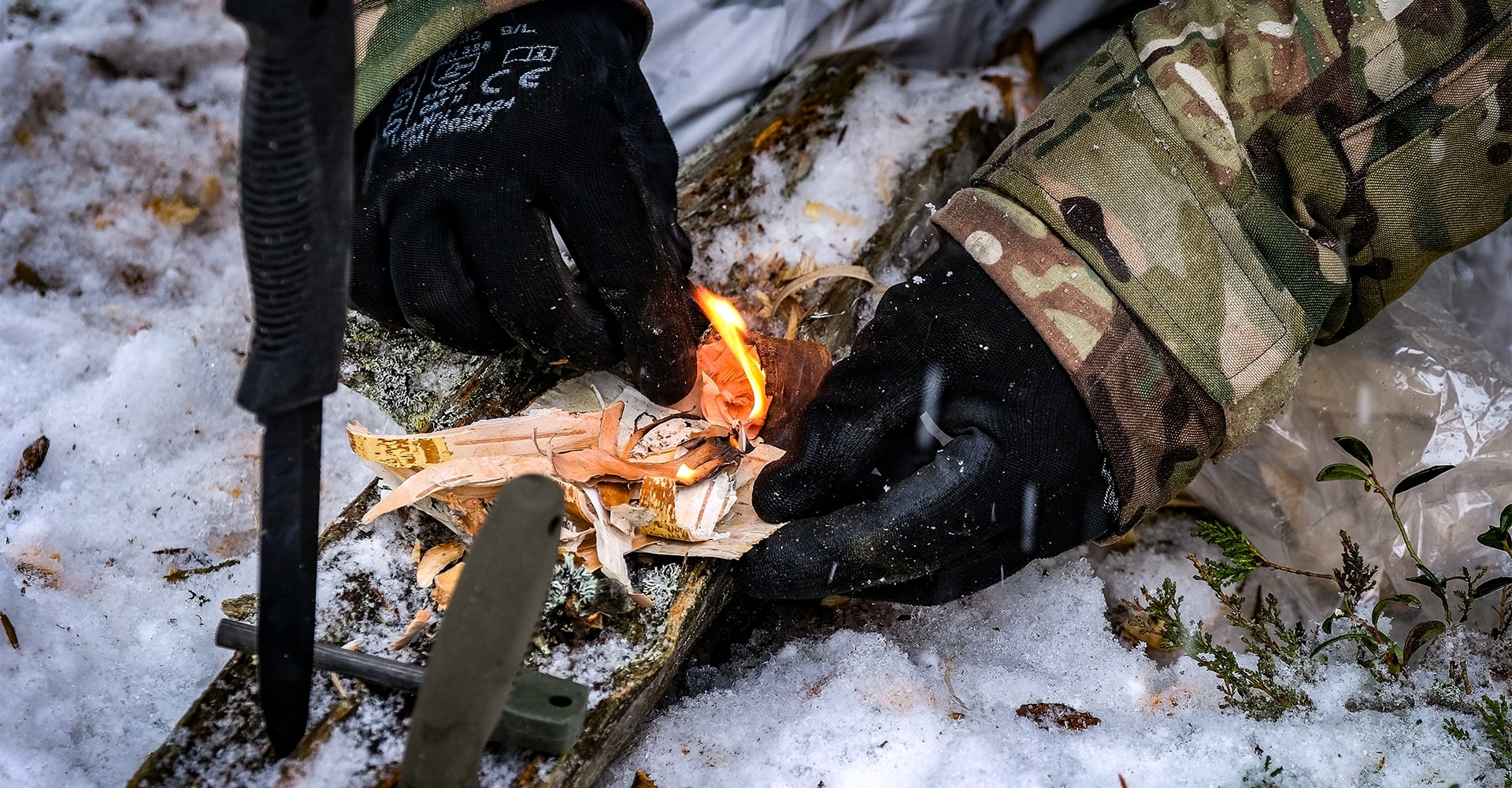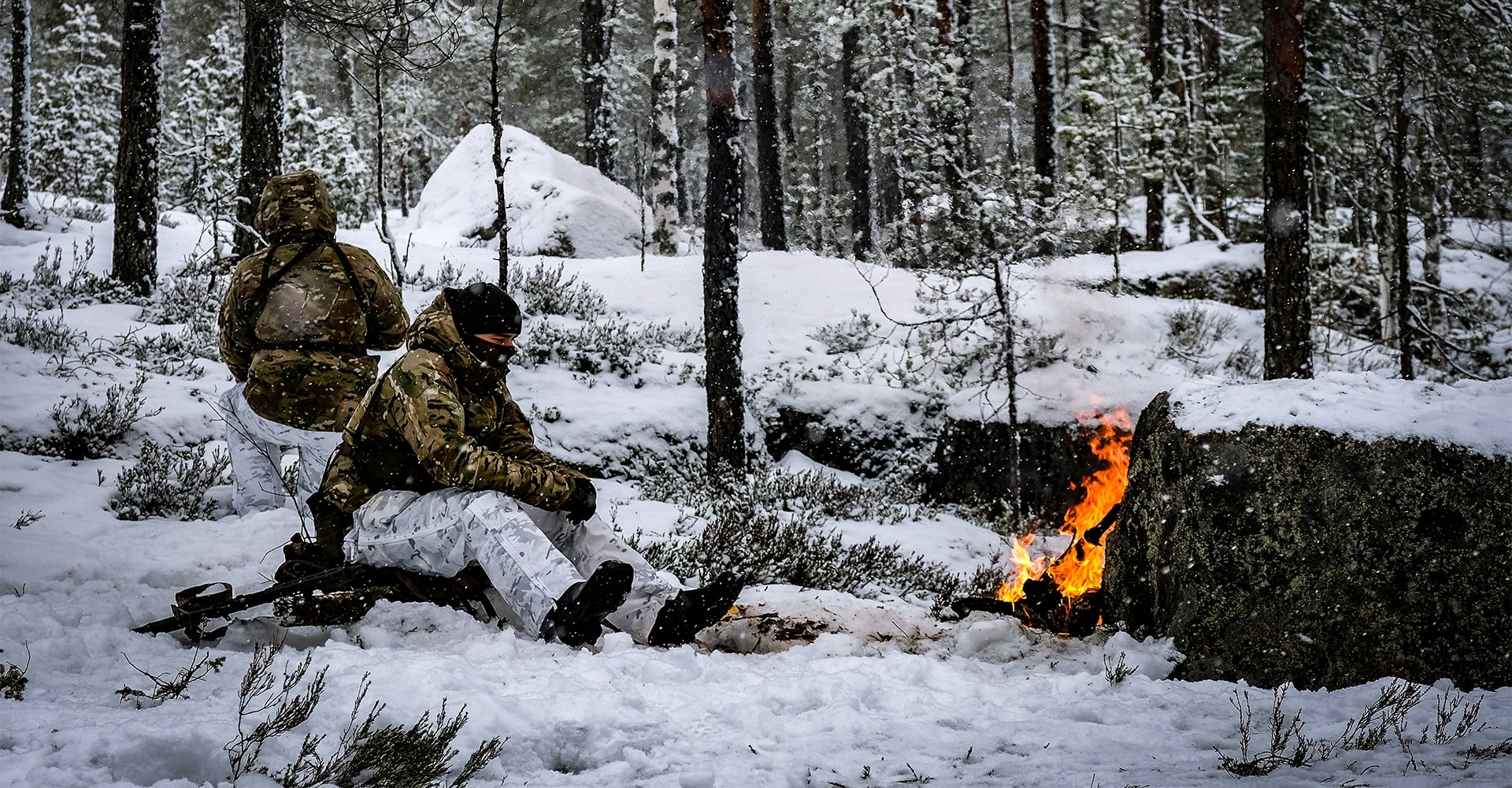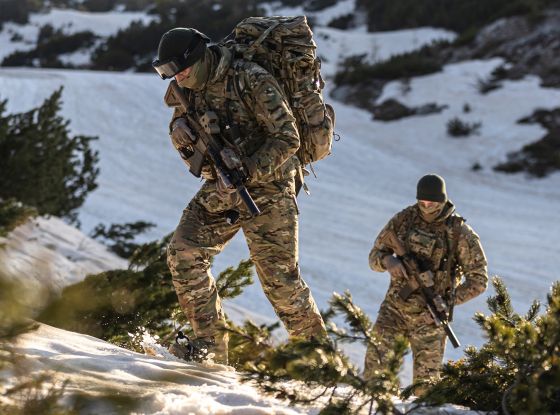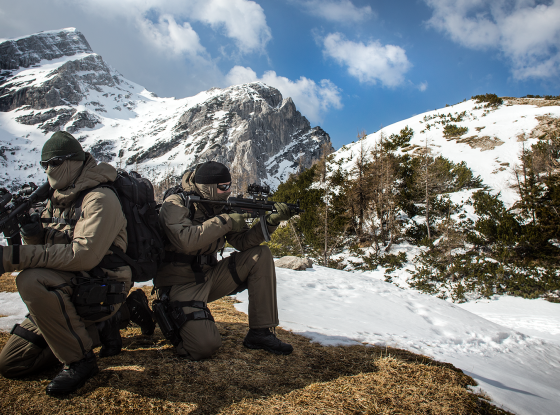The first spark dies. Then the second. You strike again. Nothing. Your breath fogs the air, your gloves are stiff, and the temperature has already stolen the feeling from your fingers.
In this blog post:
- Pre-Fire Preparation: Plan Before You’re Cold
- Choosing the Right Fire Site
- The Science Behind Fire in the Cold
- Selecting the Right Fuel Source for Starting a Fire in the Cold
- Building a Stable Fire Platform
- Tinder and Ignition: What Actually Lights
- Field-Ready Fire Starters
- Fuel Systems and Gas Limitations in Extreme Cold
- Cooking and Water Management in the Cold
- The Hidden Factor in Firecraft
- Managing Oxygen and Heat Reflection
- What Fails Most Often When Starting a Fire in Cold Weather
- Conclusion
In sub-zero environments, fire isn’t comfort. It’s the thin line between focus and fatigue, between staying in control and watching the cold take it away. And yet, what most people think they know about lighting a fire in freezing weather rarely works when it’s minus twenty and everything you touch is frozen solid.
As shown in the UF PRO Pro’s Guide to Winter Survival, this is one of the hardest lessons learned in Arctic conditions. Theory collapses fast when the cold hits back. The series takes you into real field scenarios, where professionals demonstrate how to start a fire and keep it burning when temperatures drop far below zero.
Let’s break down what truly works when the environment is against you. The methods, mindset, and preparation behind effective cold-weather firecraft and winter survival.
Pre-Fire Preparation: Plan Before You’re Cold
The best lesson in how to start a fire is that it begins long before the first spark.
In freezing environments, you can’t wait until you’re cold to act. Preparation has to happen early, while you still have daylight, dexterity, and focus.
Before setting up your fire site, build a day cache—a small reserve of kindling and fuel kept under cover. While you’re still warm and mobile, peel bark, split a few logs, and stack them in a protected spot. When night falls and your hands start to lose feeling, you’ll already have dry material ready to go.
Experienced operators also pre-plan fire points along their route. These are locations with natural cover, reflective terrain, and accessible fuel sources. Knowing where you can build a fire before conditions worsen saves time and energy later. Once fatigue and numb fingers set in, improvisation turns from skill into risk.
Choosing the Right Fire Site
Wind management is just as important as fuel.
Even a small breeze can steal heat, smother sparks, and drain energy from your fire. Choose a location protected by natural barriers such as rock faces, fallen trees, or dense vegetation. If no cover exists, build your own with snow blocks, branches, or a tarp angled away from the prevailing wind.
A well-placed fire not only burns hotter and longer but also consumes less fuel. Position it so radiant heat reflects back into your shelter or workspace. This creates a pocket of warmth and reduces exposure to the elements.
In tactical environments, terrain selection also matters for concealment. Fire built behind natural cover reduces both visible light and thermal signature.

The Science Behind Fire in the Cold
Cold air is dense, dry, and oxygen-rich, which sounds good for burning. The real challenge lies elsewhere: moisture.
Below 0 °C, every drop of water in your fuel must evaporate before ignition. That process drains heat from your flame faster than it can build it. Most fires die not from lack of oxygen but from heat loss caused by trapped moisture.
The fix isn’t more power. It’s smarter preparation.
Start small, control airflow, and remove moisture wherever possible. In the cold, survival favors heat preservation, not heat production.
Selecting the Right Fuel Source for Starting a Fire in the Cold
Not all wood burns the same once the temperature drops, a critical point in mastering how to start a fire in cold weather.
- Resin woods like pine and spruce ignite easily and burn steadily, even when the surface is damp.
- Birch bark contains natural oils that light quickly under a spark.
- Hardwoods such as oak or beech burn longer and hotter but need a strong coal base first.
- Avoid green or freshly fallen wood. The ice inside releases steam that suffocates the flame.
Whenever possible, split logs to reach the dry inner core, which can remain up to 40% drier than the outer surface even after days in snow.

SUBSCRIBE TO UNLOCK OUR EXCLUSIVE CONTENT
Enter your email and get timely updates and relevant intel on tactical topics directly to your inbox.
You are signing up to receive updates via e-mail from which you can opt out at any time. Visit our privacy policy for more info.
Building a Stable Fire Platform
Snow insulates, but it also suffocates.
A fire built directly on frozen ground melts its base, sinks, and dies.
Clear an area down to soil or pack the snow firmly, then create a platform of dry sticks or bark to raise the flame. This improves oxygen flow and prevents meltwater from extinguishing your fire.
Experienced cold-weather operators often use a two-tier platform. The lower layer absorbs moisture while the upper stays dry enough to sustain combustion. Airflow below. Reflection above. Simple physics, proven in the field.
Tinder and Ignition: What Actually Lights
When matches fail and lighters freeze, sparks become your allies.
A ferrocerium rod throws sparks at roughly 3,000 °C, hot enough to light even coarse bark. Pair it with high-energy tinder such as:
- Shaved fatwood from dead pine
- Fine feather sticks cut from dry inner bark
- Cotton pads or makeup removers soaked in oil or petroleum jelly and sealed in waterproof bags

If conditions are extreme, pre-warm your ferro rod and knife inside your jacket before striking. Warm metal transfers energy more efficiently and increases ignition success when every spark matters.
Field-Ready Fire Starters
Fine motor skills fade fast, so ignition tools must be reliable and work with gloves.
Recommended kit:
- Ferro rods with large grips
- Stormproof matches (10–15 seconds burn time)
- Chemical heat tabs (hexamine or trioxane)
Gunpowder can ignite wet tinder, but it’s unpredictable and dangerous. Stick to controlled systems you’ve trained with. In the cold, muscle memory replaces dexterity.
Some experienced operators carry a small bottle of oil as part of their fire-starting kit. A few drops on cotton or fine shavings can help extend burn time and fight moisture when conditions are severe. Use it sparingly and with control. In the cold, sustained ignition is about precision, not power, and precision is everything when you need to know how to start a fire that lasts.
Fuel Systems and Gas Limitations in Extreme Cold
In Arctic and high-altitude environments, mastering firecraft goes beyond wood and sparks. When everything around you is frozen, even your fuel systems become part of the challenge.
In these conditions, traditional fire-building isn’t always possible. Wood is often buried under snow, soaked, or simply unavailable. That’s why modern operators and expedition teams rely on compact multi-fuel stoves and liquid-fuel systems, tools that provide fast, controlled heat for melting snow, cooking, or drying essential gear when natural resources fail.
Operational efficiency also matters. During long-range patrols or multi-day movement in deep cold, building a full fire for every stop wastes energy and exposes your position. Fuel systems allow you to create a quick, low-signature heat source that works even when winds are high or fatigue sets in.
Pressurised gases behave differently once the temperature drops. Standard butane, common in lighters and camping stoves, starts losing pressure at around –5 °C and becomes almost useless by –10 °C because it can’t vaporise fast enough to sustain a flame. Propane performs better but weakens below –40 °C, while isobutane offers a balance for moderate sub-zero temperatures.
For true Arctic operations, rely on liquid-fuel or multi-fuel stoves capable of burning white gas, kerosene, or diesel. These maintain stable pressure and flame consistency even in extreme cold, ensuring you can always generate heat when it matters most.
Keep your fuel warm and ready to perform. Store canisters or bottles inside your jacket or sleeping bag overnight to prevent pressure loss. Once metal cools, even the most reliable system will fail.
Understanding how different fuels behave in the cold isn’t just technical knowledge, it’s survival knowledge.
Cooking and Water Management in the Cold
Fire is more than heat. It’s your tool for hydration, nutrition, and control.
Melting Snow for Water
Always start with a small amount of liquid water in your pot. It spreads heat evenly and prevents scorching. Add snow gradually. Dumping dry snow directly into a hot pot creates steam pockets that can extinguish your flame or warp your cookware.
Cooking for Output
Wide-based pots conserve fuel. Windscreens reduce flame loss but must allow air to circulate. When possible, cook behind natural barriers such as rock faces, trenches, or snow walls to trap warmth and conceal light.
The Hidden Factor in Firecraft
Cold-weather gear affects your ability to build and maintain fire more than most realise.
The right layering system determines how long you can stay focused and functional.

Gloves are a critical variable. Use a system that allows temporary removal of outer gloves without exposing skin for long. Thin liners retain dexterity while preventing frostbite during ignition. Keep all ignition tools close to your body so they stay warm and responsive.
Outer clothing should block wind but not restrict movement around the fire. Materials with fire-resistant or No-Melt/No-Drip properties reduce risk when working close to open flames. Wet or frozen sleeves can flash into steam burns, so regularly check your layers for ice buildup.
Managing Oxygen and Heat Reflection
Most fires die from suffocation, not exhaustion.
Arrange your fuel to channel air directly toward the ignition point. Lean-to or log-cabin structures work best. Avoid compact piles, because space between sticks keeps oxygen moving.
Position the fire near a rock face or metal panel to reflect radiant heat back toward you. A simple rock reflector can raise local temperature by up to 15 °C within half a meter of the fire, saving both fuel and focus.
What Fails Most Often When Starting a Fire in Cold Weather
Even trained operators repeat the same mistakes when learning how to start a fire in winter conditions:
- Overreliance on gas or gels that lose volatility below –10 °C
- Piling on large logs too soon
- Building windbreaks too tight, cutting off oxygen
- Rushing ignition without preparing proper tinder
- Using too much accelerant and losing control of the flame
- Kneeling directly on snow and bleeding heat into the ground
- Forgetting to dry tomorrow’s fuel
These are not minor oversights. They are energy leaks. And in the cold, every lost calorie is lost endurance.
Conclusion
Firecraft is control. The better you understand the materials, the temperature, and your own limits, the more effectively you can turn a spark into stability.
A good fire keeps you alive, restores focus, and maintains capability. A bad one wastes time, energy, and can reveal your position.






